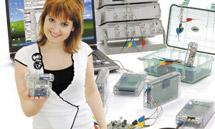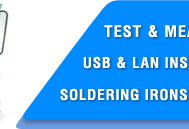|
|
ASE-3107 Temperature Controlled Soldering & Desoldering Station
ASE-3107 Temperature Controlled Soldering & Desoldering Station
|
|
Temperature controlled soldering & desoldering station is designed for electronic product research, production and rework. Max. station power: 210W.
Soldering: temperature range: 160°C - 480°C, max power: 60W, voltage supply: 24V, ceramic heating element. Desoldering: temperature range: 160°C - 480°C, max power: 80W, voltage supply: 24V, ceramic heating element.
Manuals:
|
|
ASE-3107 is a high-performance and multi-function station developed for electronic product research, production and rework. This model is used in the field of electronic research, teaching and production, especially in the repairing and reworking on the electronic appliances and communication equipment.
The soldering iron and the desoldering gun tool are controlled automatically by two micro-processors. The digital control electronics and high-quality sensor and heat exchange system guarantee precise temperature control at the soldering tip. The highest degree of temperature precision and optimal dynamic thermal behavior under load conditions is obtained by the quick and accurate recording of the measured values in a closed control circuit, and this design is especially for the lead-free production technics.
Specifications:
- Channel: 2
- Max. station power: 210W
- 2 LCDs
Soldering function:
- Temperature range: 160°C - 480°C
- Max. power: 60W
- Voltage supply: 24V
- Ceramic heating element
Desoldering function:
- Temperature range: 160°C - 480°C
- Max. power: 80W
- Voltage supply: 24V
- Ceramic heating element
| ASE-3107 Temperature Controlled Soldering & Desoldering Station - Front panel |
|
|
| ASE-3107 Temperature Controlled Soldering & Desoldering Station - Accessories |
|
|
| ASE-3107 Temperature Controlled Soldering & Desoldering Station - Rear panel |
|
|
|
| ASE-3107 Temperature Controlled Soldering & Desoldering Station - Side view |
|
|
Safety instructions
Take care of yourself!
- Please read user manual carefully before using the instrument.
- Do not use the device if there is visible damage.
- Repair and maintenance of the device can be done only by a qualified specialist of the service center.
- Before connecting the instrument to the electrical network, observe all known precautions, and make sure that the grounding system is to avoid electric shock.
- Use only those accessories that are intended for use with this device.
- While working, do not touch the metal parts near the tip of the soldering iron.
- After completion of the work, it is necessary to install the soldering gun in the regular holder of the soldering gun.
Frequently Asked Questions
How to care and use of the soldering tip?
How to clean the tip?
What temperature should use for soldering?
Why a "de-tinned" tip fails to work?
| How to care and use of the soldering tip? |
|
High soldering temperatures can degrade the tip. Use the lowest possible soldering temperature. The excellent thermal recovery characteristics ensure efficient and effective soldering event at low temperatures. This also protects the sensitive components from thermal damage. Clean the tip regularly with a cleaning sponge, as oxides and carbides from the solder and flux can form impurities on the tip. These impurities can result in defective joints or reduce the tip's heat conductivity. When using the soldering iron continuously, be sure to loosen the tip and remove all oxides least once a week. This helps to prevent reduction of the tip temperature. Never leave the soldering iron sitting at high temperature for long periods of time, as the tip's solder plating will be covered with oxide, which can greatly reduce the tip's heat conductivity. Wipe the tip and coat it with fresh solder after use. This helps to prevent tip oxidation.
Up
|
| How to clean the tip? |
|
Caution! Never file the tip to remove oxide.
- Set the temperature to 250°C.
- When the temperature stabilizes, clean the tip with the cleaning sponge and check the condition of the tip.
- If there is black oxide on the solder-plated portion of the tip, apply new solder (containing flux) and wipe the tip on the cleaning sponge. Repeat until the oxide is completely removed. Coat with new solder. The solder protects the tip from oxidation and prolongs the life of the tip.
- If the tip is deformed or heavily eroded, replace it with a new one.
Up
|
| What temperature should use for soldering? |
600°- 650°F (316°- 343°C) is a good place to start for lead-based solder and 650°- 700°F (343°- 371°C) for lead-free solder.
Note: if clots form, the temperature is too low.
Up
|
| Why a "de-tinned" tip fails to work? |
|
A de-tinned tip is one which cannot wet with solder. This exposes the plating to oxidation and degrades the heat transfer efficiency of the tip.
The de-tinning is caused by:
1) Failure to keep the tip covered with fresh solder while not in use.
2) High tip temperatures.
3) Insufficient melting in soldering operations.
4) Wiping the tip on dirty or dry sponges and rags (Always use a clean, wet, industrial grade, sulfur-free sponge).
5) Impurities in the solder, iron plating, or on the surfaces to be soldered.
Up
|
Back to the section
|
|















